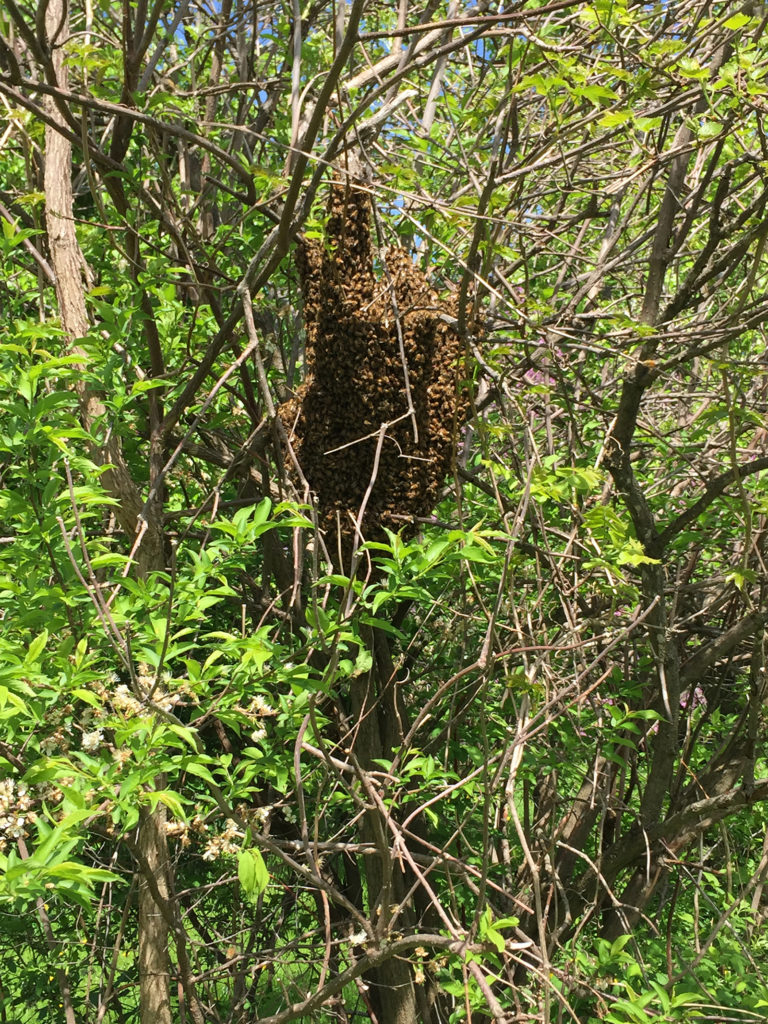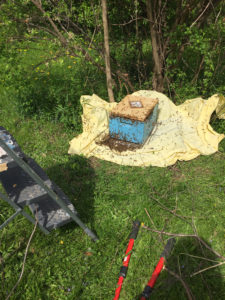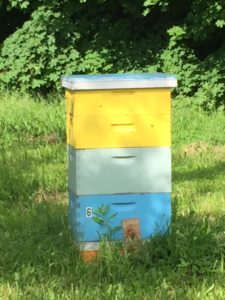Bee Lines: On the lookout for “free bees”
by Sam Hall –
Beekeepers are always on the lookout this time of year for “free bees” that is a wild swarm they can capture and add as a colony to their apiary. I got lucky a couple of weeks ago and now have a very large vigorous colony added to my apiary.

On May 21st I found a humongous swarm hanging in the Elderberry bush in my eclectic orchard. It was not from my colonies. How do I know that, because I had been keeping track of my colonies and none had yet reached the point they could have cast a swarm of that magnitude. It immediately more than filled an 8 frame deep therefore my estimate of their numbers is somewhere between 12000 and 15000 bees or more
 I had put down a sheet on the ground to avoid losing bees in the grass when I dropped the swarm into the empty super. I knew I had the Queen when I saw the bees marching into the hive. I always get a thrill when I see this. I gave them a pollen patty and put on a top feeder feeding a 50:50 water:sugar syrup.
I had put down a sheet on the ground to avoid losing bees in the grass when I dropped the swarm into the empty super. I knew I had the Queen when I saw the bees marching into the hive. I always get a thrill when I see this. I gave them a pollen patty and put on a top feeder feeding a 50:50 water:sugar syrup.
On May 23rd I went into the hive and found the Queen and marked her with a red dot for the year 2018 on her thorax. There is an international color coding system for queens which repeats itself every five years. Starting with Red this is the sequence Green, Blue, White and Yellow. While technically a queen can live longer than five years I believe that has only been done in very controlled situations like a lab. Here in Western New York you do not want to go into a winter with a queen older than two years. For our winters younger is better. Also at this time I noted that the queen had already laid eggs in a number of cells that were still being built, as I am using all new foundation this year. The bees will simply continue to build the cell as the larvae grows.

Photos by Sam Hall
On May 24th I had to add a second super. The Queen had laid up all of the available space in the first super other than where they were storing some nectar and pollen. I also replenished the syrup and pollen patty.
On June 2nd I put on two honey supers. This is an extraordinary colony. Do not know where it came from but over the years I have had probably at least 10 swarms come into my yard generally from the west. I think they may be attracted by the other bees already there but I’m not sure. If I were younger I might try to seek the reason. As it is I’m just happy they came. I would be interested if any of you have experienced this same type of thing over the years.
This is a magical and enchanting time in the apiary. Life is young and somehow it makes me young again, at least for a little while. I like laying on the ground near the entrance and watch the foragers come and go, see the guard bees turn away uninvited guests like a bouncer at a rock concert.
Mark Winston in his book Bee Time says it better than I can hope to “Bees act as connectors to acquaint us with our neighbors and stimulate deep collaborations and friendships. Their sociality and complex environmental web bees inhabit provide a muse that guides us in reflecting on who we are and want to be, with each other and the world. That’s why bee time is so compelling: As we come to know bees, we see an echo of ourselves.”
Sam Hall is a Western NY beekeeper who first worked bees as a child growing up on a ‘dirt farm’ in Allegany County, NY. He has kept bees for most of his adult life and believes that his mistakes ‘far outnumber his successes.’